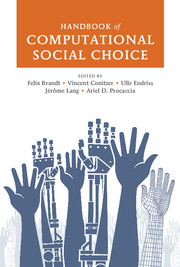16 - Weighted Voting Games
from Part III - Coalition Formation
Published online by Cambridge University Press: 05 May 2016
Summary
Introduction
In this chapter, we consider weighted voting games: a form of social choice system that seems much simpler than most schemes considered in this handbook, but which is, nevertheless, widely used for many important real-world social choice problems. There are at least two very good reasons for studying weighted voting systems: first, as we have already mentioned, they are widely used in practice; and second, for all their apparent simplicity, they possess interesting mathematical and computational properties, making them interesting objects from the point of view of scientific study.
Weighted voting games originated in the domain of cooperative game theory (Chalkiadakis et al., 2011). They model decision-making situations in which a set of voters must make a binary (yes/no) decision on some particular issue; each voter is allocated a numeric weight, and the decision is carried if the sum of weights of voters in favour of it meets or exceeds some specific given threshold, called the quota. Weighted voting games have many applications beyond social choice theory. For example, they can be used to model settings where each player has a certain amount of a given resource (say, time, money, or manpower), and there is a goal that can be reached by any coalition that possesses a sufficient amount of this resource.
The remainder of this chapter is structured as follows.
• In Section 16.2, we present the basic models and solution concepts that will be used throughout the remainder of the chapter. We start by defining cooperative games in characteristic function form, and then introduce weighted voting games. We go on to describe some key solution concepts for cooperative games: the core, the Shapley value, and the Banzhaf index.
• In Section 16.3, we consider computational properties of weighted voting games: in particular, the complexity of computing the core, the Shapley value, and the Banzhaf index.
• In Section 16.4, we consider the (sometimes unintuitive) relationship between the weight that a voter is assigned in a weighted voting game and the power that this voter then wields.
• In Section 16.5, we consider the extent to which weighted voting games can be considered as a representation scheme for yes/no voting systems (i.e., simple cooperative games). We give a condition on yes/no voting systems that is both necessary and sufficient for such a system to be representable as a weighted voting game.
- Type
- Chapter
- Information
- Handbook of Computational Social Choice , pp. 377 - 396Publisher: Cambridge University PressPrint publication year: 2016
- 4
- Cited by



